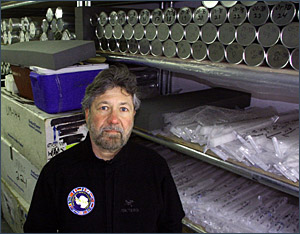|
The Great Ocean Conveyor Belt
by Daniel Grossman
part 1 2 3 4 5 6
 |
Glaciologist Paul Mayewski has gathered ice core samples from all over the world. - photo by Daniel Grossman |
In a one-story building at the University of Maine in Orono, there's a walk-in freezer for keeping ice cores like those just drilled in Greenland. They're stored in cardboard mailing tubes stacked neatly on shiny steel shelves. There's nearly a mile of ice here - most of it collected by glaciologist Paul Mayewski.
"There are ice cores in here from all over the world. Greenland, Devon Island, all over Antarctica, New Zealand."
Gingerly taking one of the plastic-wrapped cylinders off the shelf, the researcher says scientists need samples from all over the world for the same reason that meteorologists need lots of thermometers: because climate is complicated and varies greatly over time and space.
Somewhere in these records, there is the piece of ice that was formed when the constitution was signed, when Jesus was born, when the Spanish Armada tried to invade Britain.
In the late 1980s and early 1990s, Mayewski led a U.S. coring team in Greenland. Scientists studying that core made a discovery that changed the way they look at Earth's climate.
"What we discovered in that record," says Mayewski, "was what had been hinted to, but that we were able to demonstrate unequivocally; and that is that there are response to climate change that can be extremely abrupt."
The ice cores showed that more than a dozen times during and just after the last ice age, temperatures in Greenland changed suddenly by up to 18 degrees Fahrenheit. That's like jumping between Florida and Boston. Scientists have since dubbed events, like these that occur in about a decade or less, 'abrupt climate changes.'
Penn State University professor Richard Alley was on the ice sheet, with colleague Ken Taylor, when the team got the first definitive evidence of these dramatic incidents.
"He had been going very slowly, measuring small changes that were related to the seasons," says Alley. "So you would see this pretty green line on his computer display going 'weo weo weo'. And he's been doing this for a mile. Going 'weo weo weo'. And he came to ice that was completely different. It was almost as if he had gone over a cliff. He's going, 'weo weo weo. BOOM'."
They realized they were staring at the science equivalent of a smoking gun, proving that huge and dramatic changes had taken place in the climate of Greenland. Later they learned that the event wasn't some local anomaly but a humongous climate earthquake with tremors that reverberated around the world.
Alley continued, "So you find the events recorded in how much the wind was affecting the ocean off of Arabia. Or how much plants were growing in the surface waters off of Venezuela. And in fact many of these events show up in Antarctic ice cores as well. So it is very clear that this is not a Greenland story. This is a lot of the world story."
And the story includes not only changes in temperature, but also a complete overhaul of weather patterns. It's hard to predict how an abrupt change like this would affect us today. No society has ever experienced these extraordinary events. All the ones discovered so far occurred during the last ice age or soon after it ended eleven thousand years ago - way before civilization began. It's probably just as well, because some scientists say less dramatic incidents decimated some of the most sophisticated civilizations of the past.
Next - Abrupt Climate Change to Blame?
|

